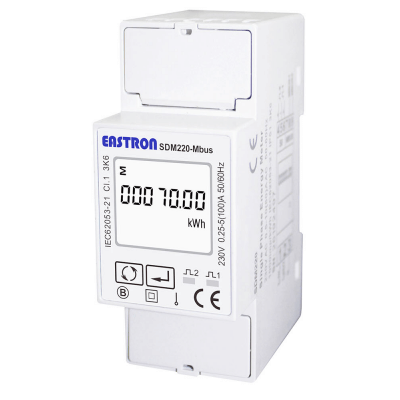Eastron SDM Energy Monitor
The sdm_meter sensor platform allows you to use Eastron SDM modbus energy monitors
(website)
with ESPHome.

The communication with this component is done via a UART using the Modbus protocol
over RS485 wiring. You will need an RS485 to UART converter for communication.
You must therefore have a uart: entry in your configuration with both the TX and RX pins set
to some pins on your board and the baud rate set to 9600bps.
! For the SDM230M, SDM120M Energy Monitor the default factory baud rate is 2400bps. You either need to change the code to 2400bps for these models or change the settings on your Energy Meter For more information search for your model: (eastron’s website).
# Example configuration entry
uart:
rx_pin: D1
tx_pin: D2
baud_rate: 9600 #if your energy meter is SDM230M or SDM120M than change the baud_rate: 2400
stop_bits: 1
sensor:
- platform: sdm_meter
phase_a:
current:
name: "SDM230M Current"
voltage:
name: "SDM230M Voltage"
active_power:
name: "SDM230M Power"
power_factor:
name: "SDM230M Power Factor"
apparent_power:
name: "SDM230M Apparent Power"
reactive_power:
name: "SDM230M Reactive Power"
phase_angle:
name: "SDM230M Phase Angle"
frequency:
name: "SDM230M Frequency"
total_power:
name: "SDM230M Total Power"
import_active_energy:
name: "SDM230M Import Active Energy"
export_active_energy:
name: "SDM230M Export Active Energy"
import_reactive_energy:
name: "SDM230M Import Reactive Energy"
export_reactive_energy:
name: "SDM230M Export Reactive Energy"
update_interval: 60sConfiguration variables
phase_a (Optional): The group of exposed sensors for Phase A/1.
current (Optional): Use the current value of the sensor in amperes. All options from Sensor.
voltage (Optional): Use the voltage value of the sensor in volts (V). All options from Sensor.
active_power (Optional): Use the (active) power value of the sensor in watts (W). All options from Sensor.
power_factor (Optional): Use the power factor value of the sensor. All options from Sensor.
apparent_power (Optional): Use the apparent power value of the sensor in volt amps (VA). All options from Sensor.
reactive_power (Optional): Use the reactive power value of the sensor in volt amps reactive (VAR). All options from Sensor.
phase_angle (Optional): Use the phase angle value of the sensor in degrees (°). All options from Sensor.
phase_b (Optional): The group of exposed sensors for Phase B/2 on applicable meters. eg: SDM630
- All options from phase_a
phase_c (Optional): The group of exposed sensors for Phase C/3 on applicable meters. eg: SDM630
- All options from phase_a
frequency (Optional): Use the frequency value of the sensor in hertz. All options from Sensor.
total_power (Optional): Use the total power value of the sensor in watts (W). All options from Sensor.
import_active_energy (Optional): Use the import active energy value of the sensor in kilowatt hours (kWh). All options from Sensor.
export_active_energy (Optional): Use the export active energy value of the sensor in kilowatt hours (kWh). All options from Sensor.
import_reactive_energy (Optional): Use the import reactive energy value of the sensor in kilovolt amps reactive hours (kVArh). All options from Sensor.
export_reactive_energy (Optional): Use the export reactive energy value of the sensor in kilovolt amps reactive hours (kVArh). All options from Sensor.
update_interval (Optional, Time): The interval to check the sensor. Defaults to
60s.address (Optional, int): The address of the sensor if multiple sensors are attached to the same UART bus. You will need to set the address of each device manually. Defaults to
1.

